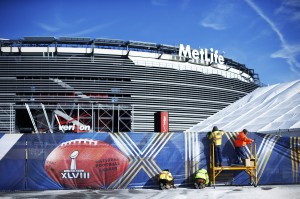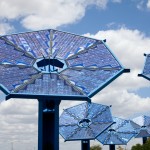Solar Comes to the Super Bowl

REUTERS /EDUARDO MUNOZ /LANDOV
Workers prepare a fence with Super Bowl ads at the Metlife Stadium in East Rutherford, New Jersey, January 28, 2014. The stadium's solar panels are visible on the roof.
Sunday’s big game will be notable for being the first “Mass Transit” Super Bowl: you can’t take a cab or a limo, and parking passes are extremely limited and expensive. If you want to get to the game, you’re likely going to be taking a train or the bus. It’s also a greener super bowl because of composting, tree plantings and biofuels. And on top of all that, MetLife Stadium will have some help from the sun.
Over a thousand solar panels will generate electricity for nearly 1,000 LED lights at the game, according to the Energy Information Administration (EIA). While solar power isn’t nearly enough to take care of a stadium’s energy needs during a game, it still makes a difference, according to Dale Sweetnam with the EIA. “These onsite energy systems can help reduce the amount of electricity pulled from the local distribution grid,” Sweetnam writes. “When stadiums are not in use, their PV systems can feed electricity into the local grid.”
MetLife Stadium isn’t the NFL venue with the most solar, that honor goes to the Philadelphia Eagles’ Lincoln Field, with three megwatts of solar. (That’s about enough to power 1,500 Texas homes during normal periods.) In second is Washington’s Fedex Field, with two megawatts.
Check out solar in the NFL in this map from the EIA:

